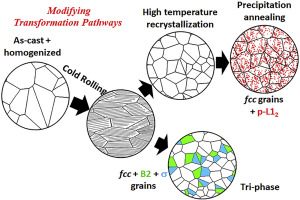当前位置:
X-MOL 学术
›
Acta Mater.
›
论文详情
Our official English website, www.x-mol.net, welcomes your feedback! (Note: you will need to create a separate account there.)
Modifying transformation pathways in High Entropy Alloys or Complex Concentrated Alloys via thermo-mechanical processing
Acta Materialia ( IF 9.4 ) Pub Date : 2018-07-01 , DOI: 10.1016/j.actamat.2018.05.009 Bharat Gwalani , Stephane Gorsse , Deep Choudhuri , Mark Styles , Yufeng Zheng , Rajiv S. Mishra , Rajarshi Banerjee
Acta Materialia ( IF 9.4 ) Pub Date : 2018-07-01 , DOI: 10.1016/j.actamat.2018.05.009 Bharat Gwalani , Stephane Gorsse , Deep Choudhuri , Mark Styles , Yufeng Zheng , Rajiv S. Mishra , Rajarshi Banerjee

|
Abstract Often the experimentally-observed, single-phase high entropy alloy (HEA) is the result of second-phase precipitation constrained by thermodynamic and kinetic factors. Using Al0.3CoCrFeNi as a candidate HEA, this paper demonstrates the strong influence of thermo-mechanical processing on the transformation pathway adopted for isothermal second-phase precipitation. A traditional thermo-mechanical processing route comprised of homogenization cold-rolling solution treatment in the single fcc phase region, followed by a precipitation anneal at a lower temperature, results in a homogeneous distribution of nanometer scale-ordered L12 (gamma prime-like) precipitates within the fcc matrix. In contrast, if cold-rolling is followed directly by annealing at the precipitation temperature, then the resulting microstructural evolution pathway changes completely, with concurrent recrystallization of the matrix fcc grains and precipitation of B2 and sigma phases, largely at the grain boundaries. These experimentally observed variations in transformation pathway have been rationalized via the competition between the thermodynamic driving force and activation barrier for second-phase nucleation in this alloy, coupled with the kinetics of the process. The microstructural variations that result from these dramatically different phase transformation pathways can lead to some rather exceptional mechanical properties that can be varied over a large range even for a single Al0.3CoCrFeNi HEA composition.
中文翻译:

通过热机械加工修改高熵合金或复杂浓缩合金的转变途径
摘要 实验观察到的单相高熵合金(HEA)通常是受热力学和动力学因素约束的第二相析出的结果。本文使用 Al0.3CoCrFeNi 作为候选 HEA,证明了热机械加工对等温第二相沉淀所采用的转变途径的强烈影响。传统的热机械加工路线包括在单一 fcc 相区域进行均质化冷轧固溶处理,然后在较低温度下进行沉淀退火,从而导致纳米级有序 L12(类伽马素)沉淀物的均匀分布在 fcc 矩阵内。相反,如果冷轧后直接在析出温度下退火,然后,由此产生的微观结构演变路径完全改变,同时发生基体 fcc 晶粒的再结晶和 B2 和 σ 相的析出,主要在晶界处。这些实验观察到的转变途径的变化已经通过热力学驱动力和该合金中第二相成核的活化势垒之间的竞争以及该过程的动力学进行了合理化。这些显着不同的相变途径导致的微观结构变化可能导致一些相当特殊的机械性能,即使对于单个 Al0.3CoCrFeNi HEA 成分,这些性能也可以在很大范围内变化。这些实验观察到的转变途径的变化已经通过热力学驱动力和该合金中第二相成核的活化势垒之间的竞争以及该过程的动力学进行了合理化。这些显着不同的相变途径导致的微观结构变化可能导致一些相当特殊的机械性能,即使对于单个 Al0.3CoCrFeNi HEA 成分,这些性能也可以在很大范围内变化。这些实验观察到的转变途径的变化已经通过热力学驱动力和该合金中第二相成核的活化势垒之间的竞争以及该过程的动力学进行了合理化。这些显着不同的相变途径导致的微观结构变化可能导致一些相当特殊的机械性能,即使对于单个 Al0.3CoCrFeNi HEA 成分,这些性能也可以在很大范围内变化。
更新日期:2018-07-01
中文翻译:

通过热机械加工修改高熵合金或复杂浓缩合金的转变途径
摘要 实验观察到的单相高熵合金(HEA)通常是受热力学和动力学因素约束的第二相析出的结果。本文使用 Al0.3CoCrFeNi 作为候选 HEA,证明了热机械加工对等温第二相沉淀所采用的转变途径的强烈影响。传统的热机械加工路线包括在单一 fcc 相区域进行均质化冷轧固溶处理,然后在较低温度下进行沉淀退火,从而导致纳米级有序 L12(类伽马素)沉淀物的均匀分布在 fcc 矩阵内。相反,如果冷轧后直接在析出温度下退火,然后,由此产生的微观结构演变路径完全改变,同时发生基体 fcc 晶粒的再结晶和 B2 和 σ 相的析出,主要在晶界处。这些实验观察到的转变途径的变化已经通过热力学驱动力和该合金中第二相成核的活化势垒之间的竞争以及该过程的动力学进行了合理化。这些显着不同的相变途径导致的微观结构变化可能导致一些相当特殊的机械性能,即使对于单个 Al0.3CoCrFeNi HEA 成分,这些性能也可以在很大范围内变化。这些实验观察到的转变途径的变化已经通过热力学驱动力和该合金中第二相成核的活化势垒之间的竞争以及该过程的动力学进行了合理化。这些显着不同的相变途径导致的微观结构变化可能导致一些相当特殊的机械性能,即使对于单个 Al0.3CoCrFeNi HEA 成分,这些性能也可以在很大范围内变化。这些实验观察到的转变途径的变化已经通过热力学驱动力和该合金中第二相成核的活化势垒之间的竞争以及该过程的动力学进行了合理化。这些显着不同的相变途径导致的微观结构变化可能导致一些相当特殊的机械性能,即使对于单个 Al0.3CoCrFeNi HEA 成分,这些性能也可以在很大范围内变化。



























 京公网安备 11010802027423号
京公网安备 11010802027423号